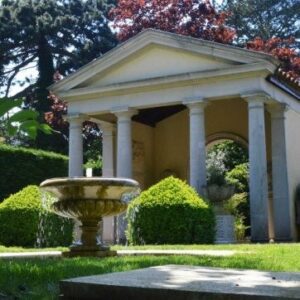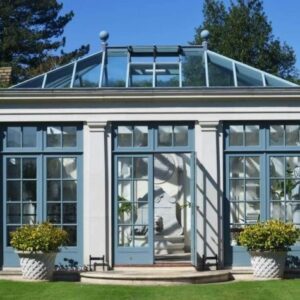

Haddonstone is a trusted, established specialist, with an enviable heritage, in the design and manufacture of architectural and garden stonework. The ranges comprise cast stone architecture in traditional, classical and contemporary designs for residential and commercial projects, and beautiful formal and informal garden, home and landscape products. All products are made to order in Northamptonshire with UK-sourced materials and are available in both standard and bespoke designs and colours. Stunning Show Gardens are located in East Haddon, near to the manufacturing facility.
Elegant and versatile, classical temples are charming stone structures that enhance a garden or landscape design scheme in luxury residential developments. They add effortless style and offer superb panoramic views of the surrounding landscape. They can even provide an exceptional seating area. Here Toby Marlow, Haddonstone’s Building and Construction Director, answers ten common garden cast temple design questions.

1. What is a garden temple?
Classical cast stone temples are charming garden buildings which give superb panoramic views of the surrounding countryside, lawn or garden. Inspired by the Ionic Roman temples of 750 BC, they are equally fitting in classical, traditional and even modern gardens and landscapes today. Chosen to enhance residential gardens and the landscapes of stately homes, hotels, spas and other commercial developments around the world, garden temples add an effortless, classical style. They can be incorporated into a design scheme to draw the eye towards a key focal point, provide an elegant outside seating area, or even to showcase a treasured statue or water feature.
Classical temples can be created using a combination of architectural components including balustrading, columns, flooring and steps. Generally, these components are made from natural or cast stone materials, the latter offering lots of flexibility in terms of design, and affordability.

2. What are the benefits of a garden temple and how can it be used?
There are countless benefits to choosing a garden temple. Firstly, they offer an elegant, sheltered space to dine and entertain throughout the warmer months. When not being used during the winter, they make the ideal outside structure to showcase a statement statue, a relaxing water feature, or even an elegant Christmas tree.
Garden temples also add structural beauty to gardens and landscapes of all sizes and are perfect for adding elegance to an outside space without the grandeur and investment of a larger orangery.
As garden cast temples are effectively ‘open’ on all sides without ‘walls’, thanks to them being constructed of columns, they provide unobstructed views of a landscape from any angle.
Moreover, garden temples are surprisingly affordable and as they are bespoke, can be made to order in a choice of sizes, colours and designs.

3. How does a garden temple differ from other garden buildings?
There are many types of garden buildings to choose from, each with their own benefits.
Both equally impressive in design, garden temples and Belvederes are ideal for a simple, elegant and practical garden building design. A garden temple is usually round in design, constructed from four or more stone columns and will be crowned by a beautiful fibreglass or metal dome.
In contrast, a Belvedere is usually square in plan and constructed of balustrades, columns, architrave and cornice. Both designs are usually finished with elegant temple flooring.
Stone pavilions and orangeries are generally considered more ‘imposing’ than garden temples and Belvederes. They offer all the benefits of a garden temple or Belvederes, but with the added bonus of providing more shelter and aesthetic clout.
A stone pavilion is generally square or rectangular in plan, constructed with at least one wall (usually to the back of the design) and surmounted by a significant architrave.
Finally, a quality orangery is usually constructed of stone with glass panelling and a glazed roof and more often than not is used as traditional ‘green houses’, or as a continuation of the architecture of the home.
4. Is planning permission required for a garden temple?
Planning permission is unlikely to be needed before installing a garden cast temple – but the advice is to check. Haddonstone garden temples are over 2.5 metres at their highest point and, as any buildings over this height cannot be positioned within two metres of a boundary, it is best to check before planning and starting installation.

5. What is the best flooring for a garden temple?
As garden temples are open on all sides and likely to receive a lot of foot traffic, flooring should be hard-wearing and practical. It is inadvisable to use tiles, wood or vinyl flooring inside any garden building design as these will more than likely succumb to weathering over time.
A robust alternative is natural or cast stone temple flooring, both of which can easily be designed to fit any garden temple shape and size.
As well as being frost-proof, both natural and cast stone temple flooring can easily be cleaned to keep a brand new appearance for longer. Available in a range of colours to complement a garden temple, natural and cast stone temple flooring can also be created with or without a step, offering versatility and choice.

6. How much does a garden temple cost?
This all depends on the size, scale, features and the design. As a bespoke garden building, the price of producing and installing a one-of-a-kind garden temple design is on application.
Haddonstone offers four beautiful garden temple design options, ranging from small, simple and stylish garden temples starting at just over £7,000 and available with or without balustrading, to a larger Classical temple available at just over £13,000. The fibreglass domes and flooring can be sold separately.
7. Will a garden temple add value to a garden?
Just like adding a high-quality orangery to your home, a garden temple can add value to a garden. Whilst the cost of adding a garden temple isn’t cheap, it is a more affordable garden building and its practicality and long-term value of owning a garden temple will certainly outweigh the costs.

8. How is a garden temple installed?
An experienced garden temple manufacturer will advise on all considerations including installation. A network of professional specialist installers is available UK-wide. Haddonstone’s standard cast temples can be ordered with a lightweight glass fibre dome, available in a lead-effect finish. For ease of installation, these are supplied in sections for your installer to put together easily and without hassle.
9. What are the top tips when considering adding a garden temple?
As a significant project, choosing the right garden temple design is paramount. The style, size and scope of the garden or landscape scheme needs to be considered. A thoughtfully, well-designed garden temple should create an elegant and practical focal point that harmonises with the landscape, rather than overpower it. The perfect garden temple design should also provide enough space for relaxing and entertaining, without encroaching too much and therefore decreasing the size of the surroundings. Different balustrading, steps, flooring and dome designs can all be combined to achieve the perfect ‘look’.
10. How is personality added to a landscape or garden design?
- Statues:Showcase a statement statue or bust inside the cast temple. For maximum impact, elevate on a complementary plinth or pedestal.
- Water features:Create a relaxing sanctuary inside a garden temple by installing a self-contained water feature.
- Lighting:Add ambiance with thoughtfully-selected lanterns, candles and string lights.
- Seating:Choose the perfect dining table and chairs or opt for relaxed seating designs.
- Planting:Soften and enhance the temple by planting around its circumference, and by adding pots, planters and urns with a range of shrubs, bedding plants and even small trees.
For further information, call 01604 770711 or visit https://www.haddonstone.com/en-gb/




